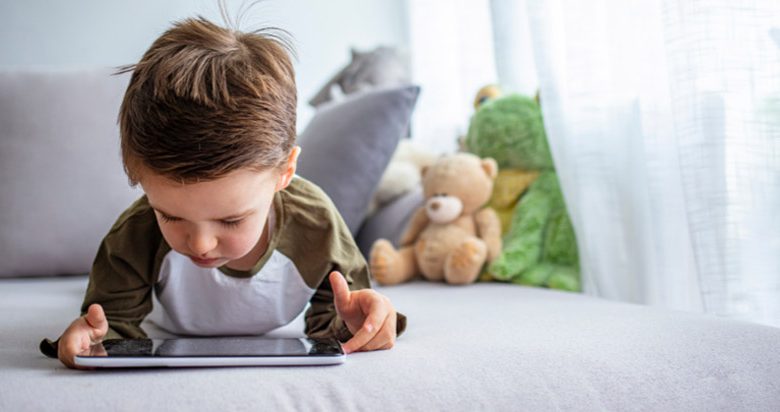Real Talk: Updates & Guidelines on Screen Time

Real Talk: Updates & Guidelines on Screen Time
The words “average screen time by age” or “kids screen time” litter the search histories of parents all around the world. If there’s one thing parents seem to collectively obsess over, it’s needing to know if they’re screwing their kids up by letting them watch Paw Patrol on their phone while they’re grocery shopping.
(By the way, has anyone done the math on how often Zuma gets put on a mission? Because it seems like he never gets deployed …)
Research and guidelines continue to be updated, so here is what the experts say, what parents can consider when setting screen time rules, and how much slack they should give themselves when it comes to monitoring their kids’ media consumption.
Recommended Average Screen Time by Age
The American Academy of Child and Adolescent Psychiatry (AACAP) has clearly defined guidelines on how much screen time they think children at different ages should have. According to them …
- Until 18 months of age, limit screen use to video chatting along with an adult.
- Between 18 and 24 months, screen time should be limited to watching educational programming with a caregiver.
- For children 2 to 5 years old, limit non-educational screen time to about 1 hour per weekday and 3 hours on the weekend.
- For ages 6 and older, encourage healthy habits and limit activities that include screens.
IMPORTANT: Because of research that points to the lack of benefits that screen time has for children under the age of 2, the guidelines we’re discussing for the rest of the article apply to kids older than 2.
The Struggle for Parents
Be honest. Did your face do this when you saw those guidelines?
If you’re feeling ashamed after reading those suggestions, give yourself some grace — you are not the only parent who struggles to meet those expectations. More than 75% of children younger than 2 and 64% of kids ages 2 to 5 exceeded the recommended guidelines, according to one study.
Even before 2020, it was hard to keep screens away from kids. Especially for single-parent homes and households where both parents work, keeping kids busy without the help of screens was hard.
Enter COVID-19, and all bets were off.
So many families simply don’t have the ability to not use screens as a way to fill time. Psychologist Candice Odgers of University of California, Irvine, studies how screen time affects kids, and she agrees. “It’s a very privileged thing to be able to do, to have this tech-free life,” she says.
Child psychologist Michael Rich at Boston Children’s Hospital puts it best: “I think one thing we have to get away from is the concept that screens are toxic. Screens are not inherently toxic. They’re neutral. It’s what we do with them that matters.”
Screen Time Real Talk
All that being said, let’s get real about what screen time means for you as a parent.
Real talk: Completely eliminating screens is impossible.
While a “Little House on the Prairie” existence may sound nice at times, we live in a digital world. Kids will be interacting with screens constantly as they grow, and the things they like to do will involve screens. Instead of asking how to get rid of screens completely, ask yourself, “How can everyone in our household have a healthy relationship with our phones, tablets, and TVs?”
Real talk: You can’t co-watch everything with your child.
Co-watching a program with your child is GREAT and should be the norm. (More on that later.) However, most of the guidance on the internet implies that 100% of their screen time should be spent with a parent.
Raise your hand if that’s possible for you.
Here’s the great news — this is one of those rare “both and” situations. For the parent looking to make dinner or pick up the house during screen time, sit down and watch a few episodes of a program with your kid and talk about the content. Then step back and check in on them as they become familiar with what’s happening.
Real Talk: Sometimes screens save your sanity.
Be honest about the times when large chunks of screen consumption is okay. Long car rides, vacations, or more formal events that require them to sit still for long periods of time are all instances where reevaluating screen time limits might be necessary.
Remember, these are the exceptions to the rule. Despite the prolific nature of screens, we don’t want a tablet to be the answer to the statement, “I’m bored.” In fact, boredom could be just the thing a child needs to get creative!
Real Talk: You don’t know how much time your kids spend on screens or what they’re watching.
Thankfully, as the concern for screen time and children’s online privacy continue to grow, there are tools that can help limit and observe the amount of time kids stay on a screen.
The easiest solution for putting a cap on screen time is using a timer that shuts your child out of the device. Sudden endings can often lead to meltdowns, so consider setting your own countdown timer and letting your child know when their screen time is coming to a close.
Advertising and inappropriate videos and websites are also major concerns for parents. Instead of handing your child your unlocked phone and hoping they don’t see something they shouldn’t, there are ways to preemptively keep it from happening.
- Many devices have kid profiles that keep unfriendly apps out of their reach and limit the amount of advertising put in front of kids.
- Pro tip: If the app your child is playing on has in-app advertisements, consider deleting it. It’s probably not educational in nature.
- Old phones and tablets that still work but aren’t connected to a phone plan can still connect to wifi. Parents can download pre-approved shows from video-viewing apps ahead of time. Without a live internet connection, the risk of your child seeing something they shouldn’t evaporates.
Real Talk: You need screen time limits, too.
Ouch. That one hurts, doesn’t it?
It’s important, though. Parents set the tone in a household. Think about it the same way you would nutrition. If you tell your kids to eat a carrot while you chomp down on a candy bar, how seriously are they going to take you? If you are constantly looking at your phone, your child will have serious objections to your insistence that they not spend their time the same way.
As a family, have an honest conversation about how much digital media you all consume. This conversation CAN’T be only about kids; adult digital consumption has to be taken into consideration. This will help create accountability between everyone in the family.
Find a Healthy Screen-Time Balance
If you’re struggling to find balance in your household when it comes to screens, here are three places to start. We think you’ll see great results with just a few changes.
- Consume media TOGETHER on a BIG screen.
We talked earlier about how co-watching with your kids isn’t possible 100% of the time. However, do everything you can to make it the norm. Co-viewing lets you answer questions, run interference if something inappropriate pops on the screen, and create a special time of bonding.
“The number one recommendation that we give to parents is [to] spend time engaged with their kids,” says Dr. Jon Lasser, a psychologist at Texas State University. “It’s simple, it’s good parenting, and it promotes a healthy relationship.”
Weirdly enough, the size of the screen matters, too. Research shows that a bigger screen offers more opportunity to interact with your child during their watching and diminishes the “tunnel vision” that can come with watching content from a small screen. - Meal times for eating and talking; bedrooms for sleeping, reading, and relaxing.
Mom and Dad, that means you, too. When it comes to devices in the bedroom, the blue light from a screen can prevent your brain from knowing when to fall asleep. Devices are also huge distractions and can tempt anyone from getting a full night of rest. Turn off screens 30 to 60 minutes before bedtime for best results.
For mealtimes, the dinner table has become an important place for families to connect and interact. Constantly watching television or looking at a tablet or phone robs you of the perfect opportunity to learn more about what’s going on in your family members’ lives.
- Be active during screen time.
Another point to promote big-screen watching, make movement a part of your screen-watching experience. If there are commercials, have a run-in-place challenge while they are on. Stretch while you watch. Play a video game that requires physical movement. Whatever you decide, just move!
The Most Important Thing for Parents
If you learn anything as a parent, it’s that life is unpredictable. Every day is different and requires something different from you. As new guidance and research comes out regarding screens and how we can better interact with them, give yourself the self-compassion you need to believe two things:
- You are doing the best you can with what you have.
- You will continue to do the best you can as the world around you changes.
With the rest of your family, strive to set boundaries that work for everyone and are sustainable. That means including your kids, too! Even if they don’t understand what the fuss is all about when it comes to screen time, be honest about why you’re thinking about it and how it’s something that everyone — including you as the parent — can benefit from.





